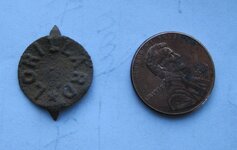pistol-pete
Hero Member
- Nov 4, 2012
- 629
- 719
- Detector(s) used
- 1970 Garrett Hunter, Garrett Ace 350, Garrett AT Gold, Garrett pinpointer
- Primary Interest:
- Metal Detecting
Dug this yesterday, anyone have an idea what it is? Says LORILLARD on it, it's iron, Penny to show size, I'm really impressed with all the knowledge you people have on old stuff. Thanks
Attachments
Last edited:





